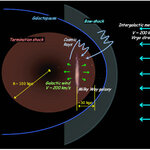Space

The chemical fingerprint of a burned-out star indicates that Earth-like planets may not be rare in the universe and could give clues to what our solar system will look like when our sun dies and becomes a white dwarf star some five billion years from now.
Astronomers from UCLA report that a white dwarf star known as GD 362, which is surrounded by dusty rings similar to those of Saturn, has been contaminated by a large asteroid that left more than a dozen observable chemical elements in the white dwarf's atmosphere. Such an observation is unprecedented in astronomy. Was there some kind of…

Astronomers have discovered a chaotic scene unlike any witnessed before in a cosmic “train wreck” between giant galaxy clusters. NASA’s Chandra X-ray Observatory and optical telescopes revealed a dark matter core that was mostly devoid of galaxies, which may pose problems for current theories of dark matter behavior.
"These results challenge our understanding of the way clusters merge," said Dr. Andisheh Mahdavi of the University of Victoria, British Columbia. "Or, they possibly make us even reexamine the nature of dark matter itself."
There are three main components to galaxy clusters:…

NASA's Galaxy Evolution Explorer has spotted an amazingly long comet-like tail behind a star streaking through space at supersonic speeds. The star, named Mira after the Latin word for "wonderful," has been a favorite of astronomers for about 400 years. It is a fast-moving, older star called a red giant that sheds massive amounts of surface material.
The space-based Galaxy Evolution Explorer scanned the popular star during its ongoing survey of the entire sky in ultraviolet light. Astronomers then noticed what looked like a comet with a gargantuan tail. In fact, material blowing off Mira is…

Recent probes inside comets show it is overwhelmingly likely that life began in space, according to a new paper by Cardiff University scientists.
Professor Chandra Wickramasinghe and colleagues at the University’s Centre for Astrobiology have long argued the case for panspermia - the theory that life began inside comets and then spread to habitable planets across the galaxy. A recent BBC Horizon documentary traced the development of the theory.
Now the team claims that findings from space probes sent to investigate passing comets reveal how the first organisms could have formed.
The 2005…

Enthusiastic observers were rewarded by a nice display of the Perseid meteor shower that was visible at its best in the night between 12 and 13 August 2007. We present glimpses of the spectacle and the scientific rewards of staying up all night.
The comet Swift-Tuttle orbits the Sun with a period of about 130 years. Whenever the comet comes close to the Sun in its orbit, it ejects a stream of dust particles, which are then distributed along its orbit. When the Earth passes through their path - a regular occurrence every August - we see a meteor shower, a fabulous spectacle for viewers on…
If you can get away from the city lights this weekend, conditions are perfect to view the annual Perseid Meteor shower that is expected to peak Sunday night and into Monday morning, August 12th and 13th. Because we will be experiencing a new moon this weekend, there will be no moonlight to interfere with the spectacular show as meteors streak across the sky. And as an added bonus, Mars will be visible as a bright red spot in the northeastern sky.
The Perseid meteors produce one of the favorite shows of the year, because of their predictability in appearing each August. They get their name…

The space shuttle Endeavour and its seven-member crew lifted off at 6:36 p.m. EDT Wednesday from NASA's Kennedy Space Center in Florida. The astronauts are on their way to the International Space Station for an assembly mission, designated STS-118.
"This is serious business we're in here," said Endeavour's Commander Scott Kelly to the shuttle launch director shortly before lift off. "I'm proud of your team for getting Endeavour ready to go fly. I'm also proud of my crew and the rest of the astronaut office for the competence and professionalism and consistently making something that is…

The new planet was identified by astronomers looking for transiting planets – that is, planets that pass in front of their home star – using a network of small automated telescopes in Arizona, California, and the Canary Islands. TrES-4 was discovered less than half a degree (about the size of the full Moon) from the team’s third planet, TrES-3.
"TrES-4 is the largest known exoplanet," said Georgi Mandushev, Lowell Observatory astronomer and the lead author of the paper announcing the discovery. "It is about 70 percent bigger than Jupiter, the Solar System’s largest planet, but less massive,…

On the night of 21 July, ESO astronomer Yuri Beletsky took images of the night sky above Paranal, the 2600m high mountain in the Chilean Atacama Desert home to ESO's Very Large Telescope. The amazing images bear witness to the unique quality of the sky, revealing not only the Milky Way in all its splendour but also the planet Jupiter and the laser beam used at Yepun, one of the 8.2-m telescopes that make up this extraordinary facility.
"The images are not composite", emphasises Yuri Beletsky. "The camera was being tracked on the stars, which can be easily noticed if you look at the telescope…

Every 62 million years there is a mass extinction on Earth. No one is sure why but, since the solar motion through the Milky Way has been computed for the past 600 million years, we know it is too long a cycle for it to be a product of our solar system. A new paper theorizes this is because the earth begins to ... wobble ... due to solar oscillations and that wobbling happens on a predictable timetable.
They call it galactic shock due to cosmic ray modulation and its presence at those times impacts biological diversity - that means extinction and origination. The physicists, Mikhail V.…